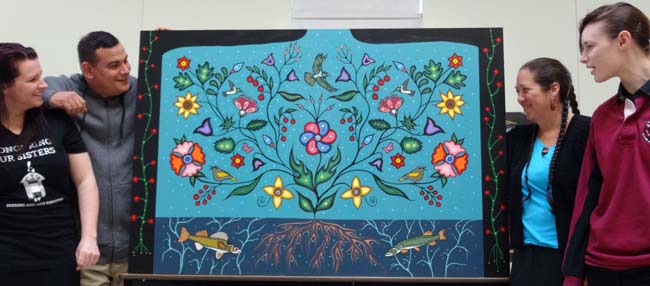Mural helps promote value of Indigenous knowledge

By Maurice Switzer
BRAMPTON – Jodie Williams was well into her university studies before she says she learned about “the real Canadian history.”
“I was so shocked and moved,” says Williams, department head of Alternative Education and First Nations, Metis, and Inuit studies at St. Thomas Aquinas Secondary School. She credits a geography course at Wilfred Laurier University for her epiphany. “A country like Canada – known for diversity – purposely hid the truth about Indigenous peoples.”
She has spent much of the past three years finding ways for her school’s 1200 students to learn some of the nasty truths about their country’s past through classroom experiences designed to contribute to a better future.
The most recent of these was a week-long project to create a mural based on a traditional Anishinabek
legend about the importance of humankind maintaining a healthy relationship with Mother Earth. Serpent River storyteller Isaac Murdoch launched the four-panel art project by relating Jiignong Aadsookaan — “The Sacred Fisher Story” — about how Creator rewarded the efforts of animals trying to undo environmental damage caused by the greedy and destructive habits of the “two-leggeds”.
Williams’ approach to help students respond to lessons about the often troubled relationship between Canada and the continent’s First Peoples – for example, the horrific legacy of the residential school system – is to develop learning opportunities that illustrate the contributions of Indigenous knowledge. Hence the assignment to make art from an Anishinabek environmental teaching.
“We’ve seen kids who were not engaged in school come to life in this project – even spending time after regular school hours helping paint the murals,” she says. “In doing this they have learned that everything they do has an impact on somebody somewhere. And the kids think: ‘I can possibly fix that.’
“They don’t have to clean up a toxic waste dump all by themselves — small and inspiring acts are important – just turning the lights in a room out when you leave, or picking up a piece of garbage. It’s not somebody else’s job; we all have to do this together.
“And Indigenous knowledge can help us find solutions. It’s bringing humanity into the classroom.”
The electric lights were all turned off in the school library during the March 6th mural unveiling.
Renowned Michif artist Christi Belcourt, currently living in Espanola, beamed at the four finished
acryclic paintings produced with her 100 apprentices.
“It’s wonderful to see the story come alive in the students’ hands,”says Belcourt, who put in several 15-hour days to shepherd the mural to completion.
The week-long initiative also presented some opportunities for St. Thomas Aquinas staff and students to learn more about Belcourt’s “Walking with Our Sisters” project – a touring exhibit of moccasin vamps (uppers) to commemorate the estimated 1,800 Indigenous women who have gone missing or been murdered in Canada in the past 30 years.
Grade 11 student Hannah Cromie, 16, said she was shocked to learn about the campaign to create more awareness about the missing and murdered women, but that her participation in the mural project helped teach her something about activism.
“We have a voice,” she told the audience at the unveiling.
Jodie Williams is past-president of the First Nations, Metis, and Inuit Education Association of Ontario, a group representing about 2,000 teachers in the province.
“Walking with Our Sisters” opens in Whitehorse in April, then travels to Comox, Ottawa, and Akwesasne before its Toronto exhibit in 2016.
Maurice Switzer is a citizen of the Mississaugas of Alderville First Nation. He is available to deliver public education presentations on Indigenous issues, with a focus on the Treaty Relationship, and can be reached at Nimkii Communications at mauriceswitzer4@gmail.com

